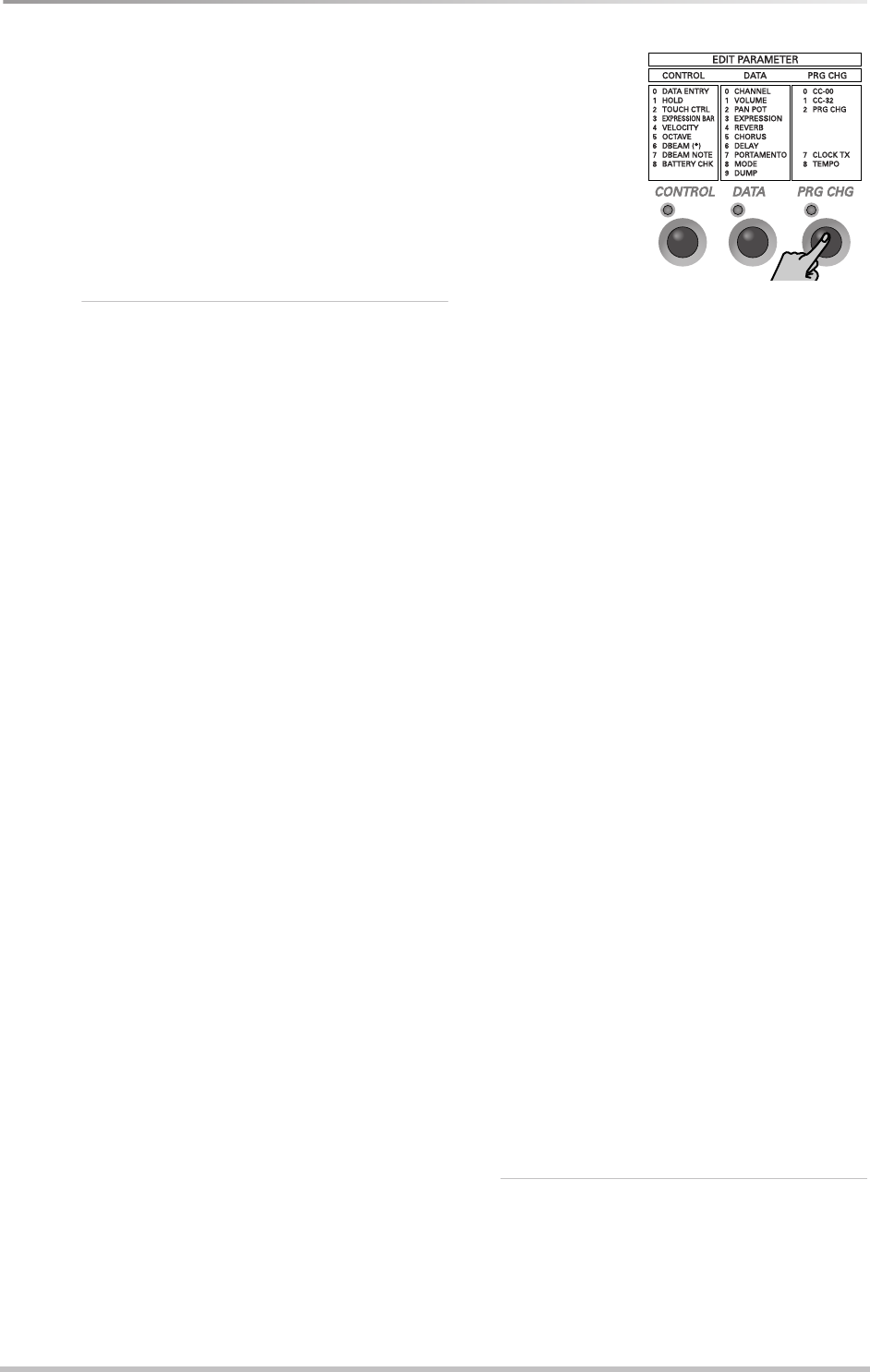
Configuring the AX-7
16
PRG CHG parameters
As can be inferred from the assigned buttons ([3]~[6] and [9] have no func-
tion), this EDIT level in fact consists of two groups: the first three parameters
can be set for both zones independently, while the last two apply to the AX-7
as a whole. Nevertheless, even these parameters are saved along with the
remaining settings (see p. 17).
See page 10 for how to select and set these parameters.
[0]
c00
, [1]
c32
(Bank Select messages)
[2]
pc
(Program Change)
Upper, Lower
Nowadays, most MIDI instruments and effects
devices contain a lot more than 128 sounds/memo-
ries. When the MIDI standard was developed, some
20 years ago, 128 memories seemed a lot, which is
why it was decided to use a dedicated message type
(Program Change) for selecting memories on an
external device.
The entire MIDI standard evolves around the magi-
cal number “128”. Given that there is no way of
expanding that number, so-called Bank Select mes-
sages were later added to accommodate the grow-
ing number of memories (synthesizers with more
than 2,000 sounds are quite common these days).
At the time, neither CC00, nor CC32 had dedicated
functions, and so these two control change mes-
sages were appointed Bank Select messages (by
Roland, by the way, with the introduction of its GS
Format).
Two bank addresses (MSB and LSB aka CC00 &
CC32) with 128 possibilities each, plus 128 Program
Change numbers provide 128 x 128 x 128 possibili-
ties – a lot more than you can eat.
Mind you, nobody has even contemplated releasing
instruments with over 2 million memories, but at
least this system provides enough flexibility for
many years to come.
On the AX-7, these three messages (CC00, CC32 and
Program Change) are always sent as a set. Transmit-
ting only Bank Select messages does nothing at all,
while working only with Program Change messages
means that you are stuck with 128 memories in the
currently active memory bank.
That is why you need to transmit:
• A value for control change CC00 (MSB)
• A value for control number CC32 (LSB)
• A Program Change number
See the manual of the receiving MIDI instru-
ment for the MSB and LSB values it supports.
As soon as you press [ENTER] to confirm the Pro-
gram Change number (after first entering and con-
firming the CC00 and CC32 values), the selected
section (Upper or Lower) immediately transmits the
memory selection cluster. If you save your settings
to a Patch, these values will also be memorized and
transmitted each time you select that Patch.
As you will notice, this procedure is very user-
friendly indeed: after pressing [0] to select c00, and
entering the desired value for CC00, pressing
[ENTER] to confirm your setting will immediately
take you to [1], where you can enter the value for
CC32.
When you confirm that value by pressing [ENTER],
you can enter the Program Change number. (There is
thus no real need to press [1] or [2] to select the
c32 and pc parameters).
As soon as you confirm the pc value (by pressing
[ENTER]), the memory selection cluster is transmit-
ted to the MIDI OUT socket.
Note: While the setting range for CC00 and CC32 is 0~127,
that of the pc parameter is 1~128.
Note: You can also select 0FF for these three parameters to
prevent the section in question from sending that message.
Note: If pc is set to 0ff, the c00 and c32 are not trans-
mitted (CC00/CC32 must always be followed by a Program
Change number).
Note: These memory selection clusters can be programmed
for the Upper and Lower sections individually.
[7]
clt
(MIDI Clock on/off)
This parameter (and the following) allow you to set
the tempo and control playback of an external
sequencer.
With this parameter, you can specify whether (0n)
or not (0FF) the AX-7 should transmit the MIDI
Clock messages set with the following parameter.
Selecting 0ff also means that the AX-7 transmits
the MIDI Clock messages received via MIDI IN. This is
not the case if you select 0n, because then, the
AX-7 transmits its own MIDI Clock signal.
Note: The AX-7 is also capable of receiving MIDI Clock mes-
sages and of retransmitting them.
[8]
tmp
(Tempo/BPM)
Here, you can set the tempo (MIDI Clock) to be
transmitted to an external sequencer. The setting
range is 20~250 BPM. This value will be transmitted
if clt is set to 0n.
AX-7_UK Page 16 Sunday, October 21, 2001 2:12 PM


















